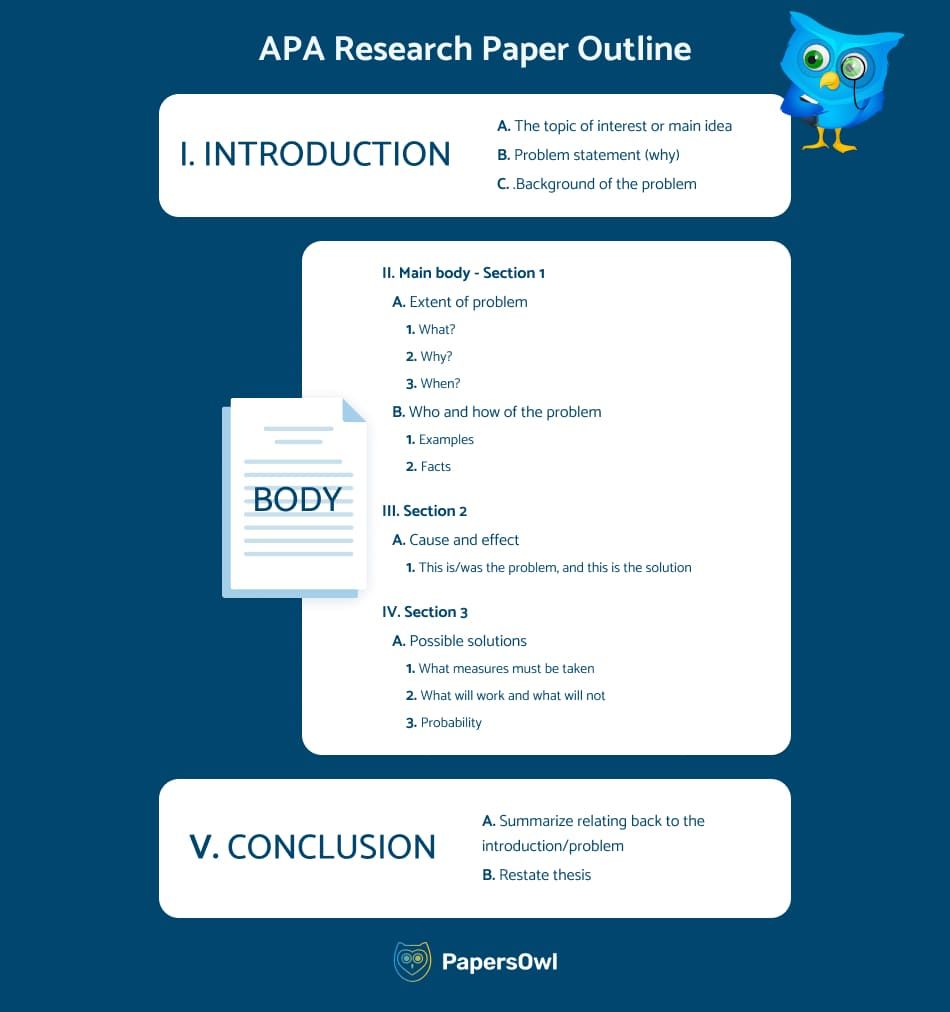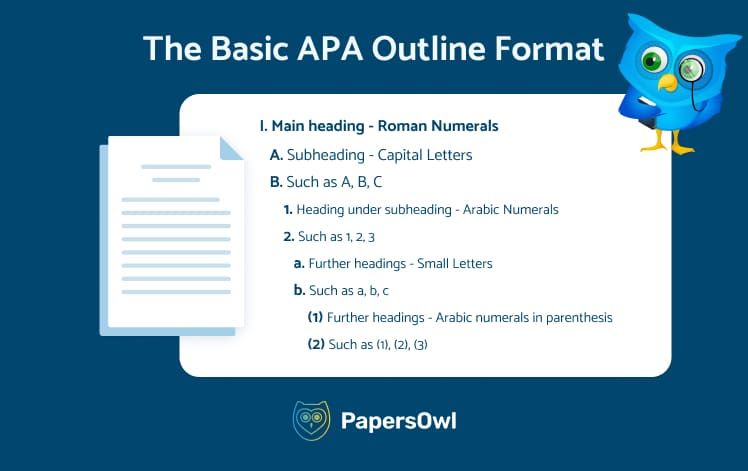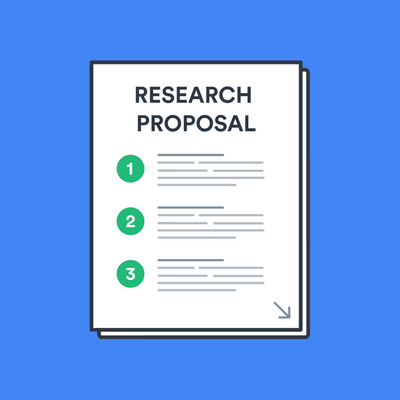Research Paper Outline Template
The most daunting part of writing a research paper is staring at a blank page and wondering where to start. A research paper outline helps you structure all the contents of your paper so you can get started, remain organized, and not leave anything out. Typically, writers create an outline before they write their first draft and after they come up with a thesis and find a research source. This article reviews how to use and format a Research Paper Outline Template to help you write a comprehensive research paper.
A research paper outline is a writing tool that highlights all the topics of a research paper in the order in which they will appear in the final document. The topics are divided into paragraphs and accompanied by additional details, such as research sources and subtopics. Essentially, the outline helps the writer organize their paper so that it makes sense and answers the thesis question. It is a more efficient tool for making structural changes than the first draft because it allows you to cut out unnecessary parts before you even write about them and add those that work for your paper.

What Is a Research Paper Outline Template?
A research paper outline template is a precontrived guideline that helps you create an outline for your paper. It is divided into the necessary sections and paragraphs with enough space for you to fill in the contents of your outline. Simply put, it is a document containing the prerequisite outline format that prevents you from writing your outline from scratch.
Are there Different Types of Research Paper Outlines?
Yes. There are several types of research paper outlines, but the following three are the most popular. Your choice of an outline format will depend on the type of paper you are writing, your writing style, the team you are working with, and more. Here is a look at your options:
- Alphanumeric Outline. The alphanumeric outline format is the most popular research paper outline. It uses Roman numerals to list the topics of a paper, capital letters for the subtopics, Arabic numerals for the points in each subtopic, and lowercase letters for subsequent sections. In this format, the information is presented in short phrases, not complete sentences.
- Decimal Outline. The decimal format is the most comprehensive research paper outline and is more common for long papers with technical aspects. It lists items using numbers with increasing decimal points. Usually, the main topics are whole numbers (1, 2, 1.0, 2.0), while the subtopics contain one decimal point (1.1, 2.1). Subsequent sections have more decimal points (1.1.1 2.1.2). Like in the alphanumeric format, the information is written in phrases or blurbs.
- Full-Sentence Outline. As the name suggests, this format presents information in complete sentences instead of short phrases. It provides a clearer way of sharing information and is more common when a group is writing a paper. In every other way, it is similar to the alphanumeric format.
Why Is Research Paper Outline Necessary?
A research paper outline lays out all the aspects of a paper that you need to explore to prove your thesis. It tells you what ideas you need to brainstorm and develop to reach a conclusion. Consequently, an outline helps you organize your thoughts so you can create the proper research protocols and achieve the intended results of your paper. It connects all your ideas to create a flow of information. This then creates a smooth transition from one point to the next, ensuring you do not leave anything out. Moreover, it helps the reader navigate and understand your research.
Essential Elements of a Research Paper Outline Template
The assignment requirements for your research paper will usually determine its content. However, research paper outlines are organized in the IMRAD format, which means they begin with an introduction followed by Methods, Results, and Discussion. These sections should be preceded by a title page and an abstract, which is a summary of the entire paper. The other sections are:
- Introduction: This brief background statement sets up the paper’s hypothesis and the research’s approach and context. It should contain the problem statement.
- Methods: Also called Experiments or Materials and Methods, this section outlines all the research methods used to write the paper.
- Results: The results part of the outline usually contains statistics and tables that summarize the findings of the research.
- Discussion: Here, the writer puts the research into perspective and supports their hypothesis in one or two paragraphs elaborating how their findings fit in the grand scheme of things.
- Acknowledgments: This is where you mention all the people or sources that helped you write your research paper.
Things to Consider When Outlining a Research Paper
What you include in your research paper outline and how you write it will ultimately depend on several factors. The type of paper you are writing can influence which format you choose. For instance, an outline for every paragraph makes sense if you are writing a formal research paper but might be excessive for a college paper. Here are some factors to consider when outlining your paper:
- The Assignment. What is the assignment? How complex is it? How long should it be? Before you start outlining your paper, you should consider what it requires. A simple research paper will do with a simple outline, while a more advanced thesis may require something more complex, such as the decimal outline format.
- Thesis and Sources. Speaking of the thesis, you should always choose one and find evidential sources for it before creating an outline. The thesis of your paper is basically what the paper is about. You should collect enough data to determine what your paper should say.
- The Topics. Next, you should review your research material and create topics, subtopics, and supporting points that relate to your thesis. Make sure every section is directly related to the thesis and is not tangential.
- The Structure and Sequence. Finally, consider how you want the topics to follow each other. You need to find a sequence that allows you to present your argument and the reader to understand it. If a reader is unfamiliar with a topic, what do they need to know before they move on to the next section?
Final Thoughts
Writing a research paper outline can seem like extra and unnecessary work, but it can save you a lot of time in the long run. The document breaks down all your ideas in their intended order, allowing you to organize your paper properly. But if writing one from scratch seems like a hassle, and it can be, you can always use a Research Paper Outline Template as a guide.
How did our templates helped you today?
Opps what went wrong, related posts.

24 FREE Story Outline Templates and Examples (Novel, Book, Plot)

Basic Speech Outline

Biography Outline Templates & Examples

Outline Template for Essay – Word, PDF

Literature Review Outline Templates (in Word & PDF)

12+ Body Outline Templates

Novel Outline Template

Autobiography Outline Template
Thank you for your feedback.
Educational resources and simple solutions for your research journey

How to Write a Research Paper Outline (with Examples)
Writing a research paper is an essential part of an academic career. However, the task can be quite challenging especially for early career researchers unfamiliar with the nuances of academic research and writing. Creating an impactful research paper demands meticulous attention to detail, an in depth understanding of the topic and research methodology, and the ability to communicate the findings in an accurate and easy to understand way. This is where a research paper outline becomes useful. Writing a research paper can be made simpler and more efficient with a well-organized plan. A well-structured research paper outline offers the fundamental foundation on which researchers can construct their narratives logically, ensuring that the study report is well-presented and interesting for readers.
Table of Contents
This article takes a look now at the benefits of having a good research paper outline and also provides guidance on creating one.
4 steps to create a well-structured research paper outline
List the key components .
To begin with, researchers must list down the key components that should be included in the research paper outline . Start with identifying your research question. Organize your key ideas and thoughts so that you are able to clearly convey the various aspects of your research question or thesis statement. Create separate points for the introduction, literature review, methodology, results, significance of your research along with its limitations. These sections will help you organize your thoughts and ensure that all relevant information is included in your research manuscript.
Structure the outline logically
As you create your outline, make sure that there is logical flow of ideas and arguments. Think through the sequence in which you will present your topic and ideas. Structure the research paper outline in a way that allows a clear and continuous narrative that is easy to understand. For example, the introduction must be concise and engaging and must clearly introduce the research topic. The main paragraphs must focus on the research problem and arguments with supporting evidence. Experts suggest using headings and sub-heads to help organize ideas and data into sub-groups. The concluding section should have a summary of your study’s main points and key takeaways with recommendations for future research.
Provide supporting evidence
It is important to provide adequate supporting evidence and examples that underpin your key idea or argument. This helps to fit your study into the larger context of your subject area. It may be a good idea to collect all your data and relevant sources right from the start. Experts suggest providing at last three supporting evidences for each of your main ideas and including appropriate and accurate citations in the research paper outline .
Review and edit
Finally, take time to review the outline and make necessary modifications as you come across new data and information. To do so, you must have sufficient knowledge of the existing and current literature on the topic. Make sure that your ideas are in a logical order, and you have not missed out anything from your research notes.
3 tips to draft a great research paper outline
- Be concise and clear: Avoid adding unnecessary details to your research paper outline . Try instead, to focus only on the key ideas, information and supporting evidence for your study. Experts suggest avoiding the use of lengthy sentences and recommend the use of short phrases, sub-heads, and bullet points to outline ideas.
- Stay consistent with formatting: To ensure consistency in formatting, researchers can choose from different kinds of research paper outline templates. The most commonly used ones are:
- The alpha-numerical template where the points are written as short sentences,
- The full sentence format where whole sentences are written with specific points
- The decimal format where the main point is presented as a whole number (1, 2) and sub-points are given as decimal points (1.1, 1.2).
- Seek feedback from supervisors: Once you have completed the outline, it is a good idea to share it with your supervisors and mentors and seek their insights. Their inputs will help ensure that your research paper outline is on track.
Research paper outline example
Given below is a research paper outline example that you can use as a starting point.
I. Introduction
- Background and context of the research topic
- Problem statement and research question
- Significance of the study
II. Literature Review
- Overview of relevant literature
- Discussion of previous research and findings
- Identification of gaps and areas for further exploration
III. Methodology
- Explanation of the research design
- Description of data collection methods
- Discussion of data analysis techniques
IV. Results
- Presentation of research findings
- Data visualization (tables, graphs, charts, etc.)
- Explanation of key results
V. Discussion
- Interpretation of the results
- Comparison with existing literature
- Addressing limitations and implications of the study
VI. Conclusion
- Summary of the research paper
- Final remarks and suggestions for future research
Researcher.Life is a subscription-based platform that unifies the best AI tools and services designed to speed up, simplify, and streamline every step of a researcher’s journey. The Researcher.Life All Access Pack is a one-of-a-kind subscription that unlocks full access to an AI writing assistant, literature recommender, journal finder, scientific illustration tool, and exclusive discounts on professional publication services from Editage.
Based on 21+ years of experience in academia, Researcher.Life All Access empowers researchers to put their best research forward and move closer to success. Explore our top AI Tools pack, AI Tools + Publication Services pack, or Build Your Own Plan. Find everything a researcher needs to succeed, all in one place – Get All Access now starting at just $17 a month !
Related Posts

What is Systematic Sampling: Definition, Advantages, Disadvantages, and Examples

What is Correlational Research: Definition, Types, and Examples
APA Research Paper Outline: Examples and Template
Table of contents
- 1 Why Is Research Paper Format Necessary?
- 2.1 Purpose of research paper outline
- 2.2 APA outline example
- 3.1 APA paper outline example
- 3.2 Introduction:
- 3.4 Conclusion:
- 4 The Basic APA Outline Format
- 5 APA Style Outline Template Breakdown
- 6.1 APA Research Paper Outline Example
- 6.2 APA Paper Outline Format Example
- 7.1 First Paragraph: Hook and Thesis
- 7.2 Main Body
- 7.3 Conclusion
- 7.4 Decimal APA outline format example
- 7.5 Decimal APA outline format layout
- 8.1 A definite goal
- 8.2 Division
- 8.3 Parallelism
- 8.4 Coordination
- 8.5 Subordination
- 8.6 Avoid Redundancy
- 8.7 Wrap it up in a good way
- 8.8 Conclusion
Formatting your paper in APA can be daunting if this is your first time. The American Psychological Association (APA) offers a guide or rules to follow when conducting projects in the social sciences or writing papers. The standard APA fromat a research paper outline includes a proper layout from the title page to the final reference pages. There are formatting samples to create outlines before writing a paper. Amongst other strategies, creating an outline is the easiest way to APA format outline template.
Why Is Research Paper Format Necessary?
Consistency in the sequence, structure, and format when writing a research paper encourages readers to concentrate on the substance of a paper rather than how it is presented. The requirements for paper format apply to student assignments and papers submitted for publication in a peer-reviewed publication. APA paper outline template style may be used to create a website, conference poster, or PowerPoint presentation . If you plan to use the style for other types of work like a website, conference poster, or even PowerPoint presentation, you must format your work accordingly to adjust to requirements. For example, you may need different line spacing and font sizes. Follow the formatting rules provided by your institution or publication to ensure its formatting standards are followed as closely as possible. However, to logically structure your document, you need a research paper outline in APA format. You may ask: why is it necessary to create an outline for an APA research paper? Crafting a well-organized APA outline is crucial for any research paper. If you’re struggling with this process, consider seeking help from a professional research paper writer , who can guide you through each step.
Concept & Purposes of Research Paper Outline
A path, direction, or action plan! Writing short essays without a layout may seem easy, but not for 10,000 or more words. Yet, confusing a table of contents with an outline is a major issue. The table of contents is an orderly list of all the chapters’ front matter, primary, and back matter. It includes sections and, often, figures in your work, labeled by page number. On the other hand, a research APA-style paper outline is a proper structure to follow.
Purpose of research paper outline
An outline is a formalized essay in which you give your own argument to support your point of view. And when you write your apa outline template, you expand on what you already know about the topic. Academic writing papers examine an area of expertise to get the latest and most accurate information to work on that topic. It serves various purposes, including:
- APA paper outline discusses the study’s core concepts.
- The research paper outlines to define the link between your ideas and the thesis.
- It provides you with manageable portions that you can handle.
- The research paper’s APA outline enables the detection of structural faults or gaps.
- As shown in the example, it must clearly comprehend the subject at hand.
Trust your APA research paper to experts! Get your paper written by a professional writer Get Help Reviews.io 4.9/5
APA outline example

This research paper outline example will guide you in formatting the layout for a clear direction to work on. It eliminates the inconsistency along with lacking proper substance in the paper.
Understanding the APA Outline Format
It would not be wrong to say there is no standard outline format. The official publishing handbook does not give precise guidelines for preparing an outline. But, it requires certain basic guidelines to follow regarding typeface, font size, structure, margins, etc.
APA paper outline example
Moreover, the final shape of your work relies on your instructor’s specifications and your particular preferences for APA citation format. Though, it would be better to follow some standards for formatting your outline, for instance:
Times New Roman is a widely accessible standard typeface for an APA essay format in 12-point font. However, serif and sans serif fonts like Arial and Georgia are acceptable in font size 11pt.
The text of your paper format should be double-spaced.
The primary headlines use Roman and Arabic numerals to write an outline.
Headings & Subheadings
While writing an APA essay, there are particular standards for utilizing headings in your outline: I – Main headings are numbered by Roman numerals like I, II, III, IV A – Subheadings are numbered with Capital letters (A, B, C, D) 1 – The APA outline uses Arabic numerals (1-9 type numbers) within those subheadings. a – Below Arabic number subheadings, lower-case letters are used (a, b, a). [1] – Headings below those subheadings use Arabic numbers enclosed in parenthesis.
APA format offers a standard layout for each paper, such as
- 1-inch margins on the top, bottom, left, and right.
- The page number on the upper right corner.
The structure of writing an outline consists of three major sections:
- Introduction
Introduction:
This section highlights crucial background information.
Explain the primary points that support your ideas.
Conclusion:
- Summarize your key arguments.
- Explain how these concepts support your ultimate stance, as shown in APA outline example below.
An outline in APA has three common formats that vary in the numeric sequence of all. To make it easier for you, we have compiled all three templates. You can format your document using these examples for added coherence and structure.


The Basic APA Outline Format

APA Style Outline Template Breakdown
Numbering the APA style format follows five levels of headings that use different alphabets and numbers. For instance, I – Headings use Roman numerals like I, II, and III. A – CAPITAL ALPHABETS”, such as A, B, C, etc. 1 – Headings and subheadings use Arabic numbers (1, 2, 3). a – If there are further headings (the fourth level), use lower-case alphabets. [1] – Headings below that (the fifth level) use Arabic numerals enclosed in parentheses, such as [1], [2], [3].
Full Sentence Outline Format
As the name specifies, the full-sentence style outline format requires every line to be a proper sentence. Full-sentence APA style outline is best recommended for essays and speeches. It gives your writing process an idea or a logical path to follow.
APA Research Paper Outline Example
If you are looking for how to write a research paper outline APA in Full Sentence Format, here is an example:
Full Sentence APA format heading utilizes Roman numerals I, II, and III. Every heading must be a full sentence. Here is an APA style paper outline template for the full-sentence format that will clear all your confusion on how to write an outline in full-sentence format.
APA Paper Outline Format Example
I. Introduction
III. Conclusion

Decimal Outline Format
The decimal outline format for APA research papers differs from other formats. The decimal APA style is simple and uses paragraphs for structure. It contains three main paragraphs, introduction, main body, and conclusion.
First Paragraph: Hook and Thesis
- The first paragraph is a sentence or two that introduces the central concept of your article.
- Introduce your topic or subject of study where your research is applicable as a context for further research.
- Explain why the mentioned issue is essential or relevant to the audience.
- A thesis statement is a claim that you make throughout your whole essay.
- The topic phrase is the first point in any writing to support a thesis statement.
- Give an explanation or provide evidence to support your point.
- Provide verifiable facts, figures, and/or citations from credible sources in your writing. It helps in the substantiating assertion.
- Include as many supporting statements and related evidence in your decimal outline.
Finally, when you write an outline, provide a concluding remark to support your claims.
Decimal APA outline format example
1.0 The main heading 1.1 Subheading under the main heading 1.2 Second digit is represented by subheadings under the main headings 1.2.1 Further division adds another digit in decimal format 1.2.2 You can number them as per the number of paragraphs or points, or lines An easy way to write in decimal APA outline format is to remember the structure, i.e.; 1.1.1 = Heading.Paragraph.Sentence/point under paragraph.”
Decimal APA outline format layout
1.0 Main heading 1.1 First paragraph for first heading. 1.2 Second paragraph for first heading. 1.2.1 First point or sentence for the second paragraph. 2.0 Second heading 2.1 Second heading, first paragraph. 2.2 Second heading, second paragraph. 2.2.1 Second, heading, second paragraph, first sentence, or point. 3.0 Decimal working 3.1 You must remember that each digit represents a segment. 3.2 It is easier to remember the placement of numbers. 3.2.1 First digit represents the heading 3.2.2 Second digit represents the paragraph under the main heading <3.2.3 The third digit represents any point or sentence under the paragraph.
Tips for Writing an Outline: Organize Your Ideas
You may feel it is easier to write without outlines, but once you start writing, organizing your ideas or thoughts becomes hard. Even if you have some fantastic ideas, producing an engaging story is practically hard. If you are not first creating an outline or conceptual guides while writing a research paper, you may lose track. A well-written outline is essential in completing your paper and maintaining quality. Establishing your point in paper writing is easy if you create an outline first. You can find an APA research paper outline template that best suits your requirement. Moreover, these tips can help you polish your writing. These tips and sample papers can help you write outstanding outlines without making any hassle.
A definite goal
For better expression, make a list of primary objectives on a title page in a single phrase or less. Your goal should be specific and measurable. If it is too broad or imprecise, you will not achieve anything. If you are working on a large paper format that covers a variety of themes or topics, you may have a more general purpose in mind. But, if you plan to write an essay, the aim should be as specific and clear as possible to be effective.
Breaking things up rather than allowing them to become verbose is known as the division rule. Make sure that each subsection in the document corresponds to its parent heading. If it doesn’t compare to the section, removing it or moving it to another location is better.
Parallelism
It is mainly related to the consistency and structure of the document. It keeps your paper’s layout tidy and also ensures relevancy. For instance, if you begin one heading with a verb, make sure all other headings and subheadings also start with a verb.
Coordination
Having headings aligned is critical to creating a well-organized outline. This rule also applies to subheadings, which is a good thing. If one title is less important than another, consider changing your layout by incorporating it into a subsection instead.
Subordination
Subordination deals with maintaining a connection between your paper’s headings and subheadings. It helps in the proper sequencing of headings and subheadings. Headings should be broad at the outset. At the same time, the subheadings become more particular as they go further into the document.
Avoid Redundancy
While writing a paper outline, look through it many times and cross out any items that aren’t necessary or have no significance. While outlining, make sure to be specific and concise. It will prevent you from adding information that does not supporting your final essay. Remove all the extra information and points while c that weighs you down while you write.
Wrap it up in a good way
Creating an outline does not only help in writing a coherent term paper, but it also helps in ending with precise understanding. Be considerate of your audience’s time and effort when you write an outline in APA, and ensure it serves its purpose. If you still have any doubts about formatting your paper outline, you can use this APA-style research paper outline template to write your document. We have provided Outline Format Example for every style.
People find it hard to write an outline in APA, but if you are aware of the requirements and structure, it’s no breeze. Sometimes, your instructor may alter your paper format by introducing or removing existing sections. As a result, if you come across any templates for an outline in APA, pay close attention to them. If you are looking for a quick answer to how to outline an APA paper, here’s a standard logical sequence of typical parts to include when writing an outline in APA:
- Thesis statement
- Techniques employed
- Body of paper
- Conclusions section
- List of references
A well-written outline is an excellent tool for presenting an outstanding paper. Including the key components while writing an outline for a research paper is necessary.
Readers also enjoyed

WHY WAIT? PLACE AN ORDER RIGHT NOW!
Just fill out the form, press the button, and have no worries!
We use cookies to give you the best experience possible. By continuing we’ll assume you board with our cookie policy.

How Can You Create a Well Planned Research Paper Outline
You are staring at the blank document, meaning to start writing your research paper . After months of experiments and procuring results, your PI asked you to write the paper to publish it in a reputed journal. You spoke to your peers and a few seniors and received a few tips on writing a research paper, but you still can’t plan on how to begin!
Writing a research paper is a very common issue among researchers and is often looked upon as a time consuming hurdle. Researchers usually look up to this task as an impending threat, avoiding and procrastinating until they cannot delay it anymore. Seeking advice from internet and seniors they manage to write a paper which goes in for quite a few revisions. Making researchers lose their sense of understanding with respect to their research work and findings. In this article, we would like to discuss how to create a structured research paper outline which will assist a researcher in writing their research paper effectively!
Publication is an important component of research studies in a university for academic promotion and in obtaining funding to support research. However, the primary reason is to provide the data and hypotheses to scientific community to advance the understanding in a specific domain. A scientific paper is a formal record of a research process. It documents research protocols, methods, results, conclusion, and discussion from a research hypothesis .
Table of Contents
What Is a Research Paper Outline?
A research paper outline is a basic format for writing an academic research paper. It follows the IMRAD format (Introduction, Methods, Results, and Discussion). However, this format varies depending on the type of research manuscript. A research paper outline consists of following sections to simplify the paper for readers. These sections help researchers build an effective paper outline.
1. Title Page
The title page provides important information which helps the editors, reviewers, and readers identify the manuscript and the authors at a glance. It also provides an overview of the field of research the research paper belongs to. The title should strike a balance between precise and detailed. Other generic details include author’s given name, affiliation, keywords that will provide indexing, details of the corresponding author etc. are added to the title page.
2. Abstract
Abstract is the most important section of the manuscript and will help the researcher create a detailed research paper outline . To be more precise, an abstract is like an advertisement to the researcher’s work and it influences the editor in deciding whether to submit the manuscript to reviewers or not. Writing an abstract is a challenging task. Researchers can write an exemplary abstract by selecting the content carefully and being concise.
3. Introduction
An introduction is a background statement that provides the context and approach of the research. It describes the problem statement with the assistance of the literature study and elaborates the requirement to update the knowledge gap. It sets the research hypothesis and informs the readers about the big research question.
This section is usually named as “Materials and Methods”, “Experiments” or “Patients and Methods” depending upon the type of journal. This purpose provides complete information on methods used for the research. Researchers should mention clear description of materials and their use in the research work. If the methods used in research are already published, give a brief account and refer to the original publication. However, if the method used is modified from the original method, then researcher should mention the modifications done to the original protocol and validate its accuracy, precision, and repeatability.
It is best to report results as tables and figures wherever possible. Also, avoid duplication of text and ensure that the text summarizes the findings. Report the results with appropriate descriptive statistics. Furthermore, report any unexpected events that could affect the research results, and mention complete account of observations and explanations for missing data (if any).
6. Discussion
The discussion should set the research in context, strengthen its importance and support the research hypothesis. Summarize the main results of the study in one or two paragraphs and show how they logically fit in an overall scheme of studies. Compare the results with other investigations in the field of research and explain the differences.
7. Acknowledgments
Acknowledgements identify and thank the contributors to the study, who are not under the criteria of co-authors. It also includes the recognition of funding agency and universities that award scholarships or fellowships to researchers.
8. Declaration of Competing Interests
Finally, declaring the competing interests is essential to abide by ethical norms of unique research publishing. Competing interests arise when the author has more than one role that may lead to a situation where there is a conflict of interest.
Steps to Write a Research Paper Outline
- Write down all important ideas that occur to you concerning the research paper .
- Answer questions such as – what is the topic of my paper? Why is the topic important? How to formulate the hypothesis? What are the major findings?
- Add context and structure. Group all your ideas into sections – Introduction, Methods, Results, and Discussion/Conclusion.
- Add relevant questions to each section. It is important to note down the questions. This will help you align your thoughts.
- Expand the ideas based on the questions created in the paper outline.
- After creating a detailed outline, discuss it with your mentors and peers.
- Get enough feedback and decide on the journal you will submit to.
- The process of real writing begins.
Benefits of Creating a Research Paper Outline
As discussed, the research paper subheadings create an outline of what different aspects of research needs elaboration. This provides subtopics on which the researchers brainstorm and reach a conclusion to write. A research paper outline organizes the researcher’s thoughts and gives a clear picture of how to formulate the research protocols and results. It not only helps the researcher to understand the flow of information but also provides relation between the ideas.
A research paper outline helps researcher achieve a smooth transition between topics and ensures that no research point is forgotten. Furthermore, it allows the reader to easily navigate through the research paper and provides a better understanding of the research. The paper outline allows the readers to find relevant information and quotes from different part of the paper.
Research Paper Outline Template
A research paper outline template can help you understand the concept of creating a well planned research paper before beginning to write and walk through your journey of research publishing.
1. Research Title
A. Background i. Support with evidence ii. Support with existing literature studies
B. Thesis Statement i. Link literature with hypothesis ii. Support with evidence iii. Explain the knowledge gap and how this research will help build the gap 4. Body
A. Methods i. Mention materials and protocols used in research ii. Support with evidence
B. Results i. Support with tables and figures ii. Mention appropriate descriptive statistics
C. Discussion i. Support the research with context ii. Support the research hypothesis iii. Compare the results with other investigations in field of research
D. Conclusion i. Support the discussion and research investigation ii. Support with literature studies
E. Acknowledgements i. Identify and thank the contributors ii. Include the funding agency, if any
F. Declaration of Competing Interests
5. References
Download the Research Paper Outline Template!
Have you tried writing a research paper outline ? How did it work for you? Did it help you achieve your research paper writing goal? Do let us know about your experience in the comments below.
Downloadable format shared which is great. 🙂
Rate this article Cancel Reply
Your email address will not be published.

Enago Academy's Most Popular Articles

- Reporting Research
Academic Essay Writing Made Simple: 4 types and tips
The pen is mightier than the sword, they say, and nowhere is this more evident…

- AI in Academia
- Trending Now
Simplifying the Literature Review Journey — A comparative analysis of 5 AI summarization tools
Imagine having to skim through and read mountains of research papers and books, only to…

Choosing the Right Analytical Approach: Thematic analysis vs. content analysis for data interpretation
In research, choosing the right approach to understand data is crucial for deriving meaningful insights.…

Comparing Cross Sectional and Longitudinal Studies: 5 steps for choosing the right approach
The process of choosing the right research design can put ourselves at the crossroads of…

- Career Corner
Unlocking the Power of Networking in Academic Conferences
Embarking on your first academic conference experience? Fear not, we got you covered! Academic conferences…
Setting Rationale in Research: Cracking the code for excelling at research
Mitigating Survivorship Bias in Scholarly Research: 10 tips to enhance data integrity
The Power of Proofreading: Taking your academic work to the next level
Facing Difficulty Writing an Academic Essay? — Here is your one-stop solution!

Sign-up to read more
Subscribe for free to get unrestricted access to all our resources on research writing and academic publishing including:
- 2000+ blog articles
- 50+ Webinars
- 10+ Expert podcasts
- 50+ Infographics
- 10+ Checklists
- Research Guides
We hate spam too. We promise to protect your privacy and never spam you.
- Industry News
- Publishing Research
- Promoting Research
- Diversity and Inclusion
- Infographics
- Expert Video Library
- Other Resources
- Enago Learn
- Upcoming & On-Demand Webinars
- Open Access Week 2024
- Peer Review Week 2024
- Conference Videos
- Enago Report
- Journal Finder
- Enago Plagiarism & AI Grammar Check
- Editing Services
- Publication Support Services
- Research Impact
- Translation Services
- Publication solutions
- AI-Based Solutions
- Thought Leadership
- Call for Articles
- Call for Speakers
- Author Training
- Edit Profile
I am looking for Editing/ Proofreading services for my manuscript Tentative date of next journal submission:

What factors would influence the future of open access (OA) publishing?
Reference management. Clean and simple.
Getting started with your research paper outline

Levels of organization for a research paper outline
First level of organization, second level of organization, third level of organization, fourth level of organization, tips for writing a research paper outline, research paper outline template, my research paper outline is complete: what are the next steps, frequently asked questions about a research paper outline, related articles.
The outline is the skeleton of your research paper. Simply start by writing down your thesis and the main ideas you wish to present. This will likely change as your research progresses; therefore, do not worry about being too specific in the early stages of writing your outline.
A research paper outline typically contains between two and four layers of organization. The first two layers are the most generalized. Each layer thereafter will contain the research you complete and presents more and more detailed information.
The levels are typically represented by a combination of Roman numerals, Arabic numerals, uppercase letters, lowercase letters but may include other symbols. Refer to the guidelines provided by your institution, as formatting is not universal and differs between universities, fields, and subjects. If you are writing the outline for yourself, you may choose any combination you prefer.
This is the most generalized level of information. Begin by numbering the introduction, each idea you will present, and the conclusion. The main ideas contain the bulk of your research paper 's information. Depending on your research, it may be chapters of a book for a literature review , a series of dates for a historical research paper, or the methods and results of a scientific paper.
I. Introduction
II. Main idea
III. Main idea
IV. Main idea
V. Conclusion
The second level consists of topics which support the introduction, main ideas, and the conclusion. Each main idea should have at least two supporting topics listed in the outline.
If your main idea does not have enough support, you should consider presenting another main idea in its place. This is where you should stop outlining if this is your first draft. Continue your research before adding to the next levels of organization.
- A. Background information
- B. Hypothesis or thesis
- A. Supporting topic
- B. Supporting topic
The third level of organization contains supporting information for the topics previously listed. By now, you should have completed enough research to add support for your ideas.
The Introduction and Main Ideas may contain information you discovered about the author, timeframe, or contents of a book for a literature review; the historical events leading up to the research topic for a historical research paper, or an explanation of the problem a scientific research paper intends to address.
- 1. Relevant history
- 2. Relevant history
- 1. The hypothesis or thesis clearly stated
- 1. A brief description of supporting information
- 2. A brief description of supporting information
The fourth level of organization contains the most detailed information such as quotes, references, observations, or specific data needed to support the main idea. It is not typical to have further levels of organization because the information contained here is the most specific.
- a) Quotes or references to another piece of literature
- b) Quotes or references to another piece of literature
Tip: The key to creating a useful outline is to be consistent in your headings, organization, and levels of specificity.
- Be Consistent : ensure every heading has a similar tone. State the topic or write short sentences for each heading but avoid doing both.
- Organize Information : Higher levels of organization are more generally stated and each supporting level becomes more specific. The introduction and conclusion will never be lower than the first level of organization.
- Build Support : Each main idea should have two or more supporting topics. If your research does not have enough information to support the main idea you are presenting, you should, in general, complete additional research or revise the outline.
By now, you should know the basic requirements to create an outline for your paper. With a content framework in place, you can now start writing your paper . To help you start right away, you can use one of our templates and adjust it to suit your needs.
After completing your outline, you should:
- Title your research paper . This is an iterative process and may change when you delve deeper into the topic.
- Begin writing your research paper draft . Continue researching to further build your outline and provide more information to support your hypothesis or thesis.
- Format your draft appropriately . MLA 8 and APA 7 formats have differences between their bibliography page, in-text citations, line spacing, and title.
- Finalize your citations and bibliography . Use a reference manager like Paperpile to organize and cite your research.
- Write the abstract, if required . An abstract will briefly state the information contained within the paper, results of the research, and the conclusion.
An outline is used to organize written ideas about a topic into a logical order. Outlines help us organize major topics, subtopics, and supporting details. Researchers benefit greatly from outlines while writing by addressing which topic to cover in what order.
The most basic outline format consists of: an introduction, a minimum of three topic paragraphs, and a conclusion.
You should make an outline before starting to write your research paper. This will help you organize the main ideas and arguments you want to present in your topic.
- Consistency: ensure every heading has a similar tone. State the topic or write short sentences for each heading but avoid doing both.
- Organization : Higher levels of organization are more generally stated and each supporting level becomes more specific. The introduction and conclusion will never be lower than the first level of organization.
- Support : Each main idea should have two or more supporting topics. If your research does not have enough information to support the main idea you are presenting, you should, in general, complete additional research or revise the outline.


IMAGES
VIDEO
COMMENTS
Research Paper Outline Example on Cyber Security: Introduction A. Overview of Cybersecurity Cybersecurity refers to the protection of computer systems, networks, and sensitive data from unauthorized a…
How to write a research paper outline. Follow these steps to start your research paper outline: Decide on the subject of the paper; Write down all the ideas you want to include or discuss; Organize related ideas into sub …
A research paper outline helps you structure all the contents of your paper so you can get started, remain organized, and not leave anything out. Typically, writers create an outline before they write their first draft and after they come …
5. Begin writing your paper. You may start by constructing a research paper outline which we discussed earlier and follow it by writing a rough draft. Remember, there is …
4 steps to create a well-structured research paper outline. List the key components. To begin with, researchers must list down the key components that should be included in the research paper outline. Start with …
Templates and tips on writing APA research paper outline: Decimal Full Sentence Format and Basic APA style outline. Click to see examples.
A research paper outline is a basic format for writing an academic research paper. In this article, we would like to discuss writing an outline with a structured research paper outline template, which will assist a …
Structuring the outline of your research paper early on is important. Read on to learn how to structure a research paper outline and to see examples, including an outline template.
Learn how to create a research paper outline with free templates and examples. Simplify your writing process with step-by-step guidance and formatting tips.